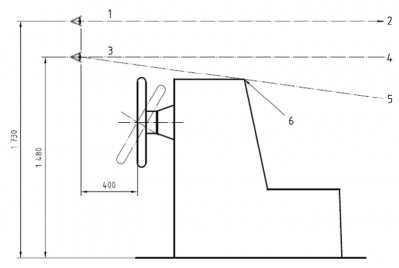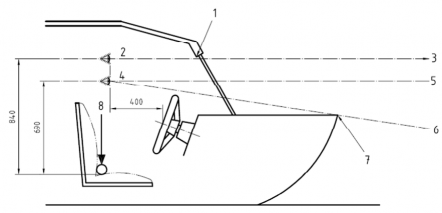

< Previous | Contents | Next >
Section 3 Field of Vision from Steering Position
301. General
1. All glazing through which vision from the steering position shall have transmission.
at least 70 % light
2. For ships having more than one steering station and position designed to be used from either standing or sitting, are to be complied with the requirements of KS V ISO 15085 from at least one of the steering stations and position.
3. Throttle and shift controls, as intended for use by the steersman, shall be positioned within 0.7 m of the high eye position and shall enable the maintenance of at least the low eye position by the steersman at all throttle settings. For ships designed to be operated from both the seated and stand- ing positions, the controls shall be located to meet these requirements from at least the seated position.
4. The requirements for the low eye position may be met by a steersman's seat with vertical height adjustment.
5. Permanent and removable tops and/or other structural parts and mounted instruments in the vicinity of the steersman shall not obstruct forward vision.
6. Field vision of fore and aft is to comply with the requirements of KS V ISO 15085.
302. Definition
1. High eye position (standing position)
Position of 1730 mm above the surface on which the steersman stands, 400 mm from the centre of the steering-wheel rim. (See Fig 7.4)
2. High eye position (seated position)
Position of 840 mm above the intersection of the compressed seat and the seat back, 400 mm from the centre of the steering-wheel rim. (See Fig 7.5)
3. Low eye position (standing position)
Position of 1480 mm above the surface on which the steersman stands, 400 mm from the centre of the steering-wheel rim. (See Fig 7.4)
4. Low eye position (seated position)
Position of 840 mm above the intersection of the compressed seat and the seat back, 400 mm from the centre of the steering-wheel rim. (See Fig 7.5)
5. Compressed seat bottom
Surface of the centre of the steering seat at the intersection of the seat-back and seat-bottom when compressed by a 25 mm diameter spherical object under a vertical load of 100N. (See Fig 7.5)
6. Vertical range of vision
Range between the lowest unobstructed line of vision from the low eye position and the highest unobstructed line of vision from the high eye position. ![]()
Ch 7 Steering System Ch 7
![]()

1. High eye position
2. To horizon
3. Low eye position
4. Required vertical range of vision
5. Lowest unobstructed line of vision
6. Point of visual obstruction
Fig 7.4 Eye positions and vertical range of vision - steersman in standing position

1. Vision obstruction
2. High eye position
3. To horizon
4. Low eye position
5. Required vertical range of vision
6. Lowest unobstructed line of vision
7. Point of visual obstruction
8. Seat compression
Fig 7.5 Eye positions and vertical range of vision - steersman in seated position
Ch 8 Machinery Installations Ch 8
![]()